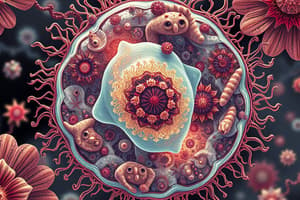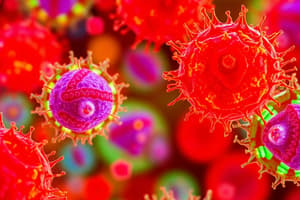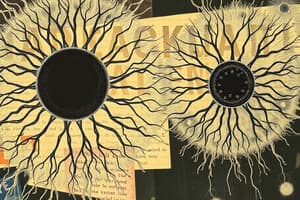Podcast
Questions and Answers
What is the term for the observable characteristics of an organism, as determined by its genes?
What is the term for the observable characteristics of an organism, as determined by its genes?
- Phenotype (correct)
- Allele
- Genotype
- Chromosome
Which of the following is NOT a key ecological concept?
Which of the following is NOT a key ecological concept?
- Food chains and food webs
- Nutrient cycling
- Energy flow in ecosystems
- Cellular respiration (correct)
What is the role of decomposers in an ecosystem?
What is the role of decomposers in an ecosystem?
- To produce oxygen
- To break down dead organic matter (correct)
- To convert sunlight into energy
- To consume other organisms
Which of the following is an example of an abiotic factor in an ecosystem?
Which of the following is an example of an abiotic factor in an ecosystem?
What is the term for the maximum population size that an environment can sustain?
What is the term for the maximum population size that an environment can sustain?
What are the basic structural and functional units of all living organisms?
What are the basic structural and functional units of all living organisms?
Which of the following is NOT a characteristic of prokaryotic cells?
Which of the following is NOT a characteristic of prokaryotic cells?
What is the primary function of the nucleus in a eukaryotic cell?
What is the primary function of the nucleus in a eukaryotic cell?
Which organelle is responsible for converting energy from nutrients into a usable form for the cell?
Which organelle is responsible for converting energy from nutrients into a usable form for the cell?
What type of cell transport requires energy to move substances across a membrane?
What type of cell transport requires energy to move substances across a membrane?
Which of the following is NOT a characteristic of passive transport?
Which of the following is NOT a characteristic of passive transport?
What is the molecule that carries genetic information in living organisms?
What is the molecule that carries genetic information in living organisms?
What is the relationship between genes and proteins?
What is the relationship between genes and proteins?
Flashcards
Biology
Biology
The scientific study of life and living organisms.
Cells
Cells
Basic structural and functional units of all living organisms.
Prokaryotic Cells
Prokaryotic Cells
Simple cells lacking a nucleus and membrane-bound organelles.
Eukaryotic Cells
Eukaryotic Cells
Signup and view all the flashcards
Passive Transport
Passive Transport
Signup and view all the flashcards
Active Transport
Active Transport
Signup and view all the flashcards
DNA
DNA
Signup and view all the flashcards
Genes
Genes
Signup and view all the flashcards
Dominant Allele
Dominant Allele
Signup and view all the flashcards
Genotype
Genotype
Signup and view all the flashcards
Ecosystem
Ecosystem
Signup and view all the flashcards
Food Chain
Food Chain
Signup and view all the flashcards
Nutrient Cycling
Nutrient Cycling
Signup and view all the flashcards
Study Notes
Introduction to Biology for Grade 10
- Biology is the scientific study of life and living organisms.
- Grade 10 biology often covers foundational concepts, including cells, genetics, and basic ecology.
- This level lays the groundwork for more advanced biological studies in higher grades.
Cells - The Fundamental Units of Life
- Cells are the basic structural and functional units of all living organisms.
- All organisms are composed of cells.
- Some organisms are unicellular, meaning they consist of a single cell, while others are multicellular, comprised of many cells.
- There are two major types of cells: prokaryotic and eukaryotic.
- Prokaryotic cells are typically simpler and lack a nucleus or membrane-bound organelles.
- Eukaryotic cells are more complex and possess a nucleus and various membrane-bound organelles.
Cell Structure and Function
- Cell organelles are specialized structures within the cell that perform specific functions vital for the cell's survival.
- Some crucial organelles include the nucleus, mitochondria, ribosomes, endoplasmic reticulum, Golgi apparatus, and vacuoles.
- The nucleus is the control center of the cell containing the genetic material (DNA).
- Mitochondria are the powerhouses of the cell, responsible for cellular respiration (converting energy from nutrients into usable energy).
- Ribosomes synthesize proteins.
- The endoplasmic reticulum helps in protein synthesis and transport.
- The Golgi apparatus processes and packages proteins for secretion.
- Vacuoles store water, nutrients, and waste products.
Cell Transport
- Cells need to transport materials in and out.
- Passive transport (diffusion, osmosis) does not require energy.
- Diffusion is the movement of substances from an area of high concentration to an area of low concentration.
- Osmosis is the movement of water across a semipermeable membrane from an area of high water concentration to an area of low water concentration.
- Active transport requires energy and moves materials against a concentration gradient.
Genetics
- Genetics deals with heredity, or how traits are passed from parents to offspring.
- Chromosomes contain genes, which carry the instructions for building and controlling the organism.
- DNA is the molecule that carries genetic information.
- The structure of DNA is a double helix.
- Genes code for proteins, which determine characteristics (traits).
Mendelian Genetics
- Gregor Mendel's experiments laid the foundation for understanding inheritance patterns.
- Mendel introduced concepts like dominant and recessive alleles.
- Alleles are different versions of a gene.
- Genotype is the genetic makeup of an organism.
- Phenotype is the observable characteristics (traits) of an organism.
Ecology - The Study of Interdependence in Nature
- Ecology studies how organisms interact with each other and with their environment.
- Ecosystems are composed of living organisms (biotic factors) and non-living components (abiotic factors).
- Key ecological concepts include:
- Food chains and food webs
- Energy flow in ecosystems
- Nutrient cycling
- Population dynamics
- Interactions between organisms (competition, predation, symbiosis)
Basic Ecology Concepts
- Organisms in an ecosystem are interdependent.
- Food chains show the flow of energy through an ecosystem.
- Food webs are more complex, depicting interconnected food chains.
- Producers, consumers, and decomposers are crucial roles in the ecosystem.
- Nutrient cycles recycle essential elements and nutrients.
- Population sizes change based on factors like birth rate, death rate, and environmental conditions (carrying capacity).
Studying That Suits You
Use AI to generate personalized quizzes and flashcards to suit your learning preferences.




